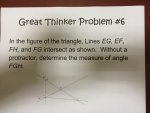You are using an out of date browser. It may not display this or other websites correctly.
You should upgrade or use an alternative browser.
You should upgrade or use an alternative browser.
great thinker problem
- Thread starter truth83
- Start date
D
Deleted member 4993
Guest

given 3 lines I can make several parallel lines to create similar triangles, etc. But I am stuck. I keep solving it in terms of another unknown.
What "other unknown" - show it!
Please share your work with us ...even if you know it is wrong
If you are stuck at the beginning tell us and we'll start with the definitions.
You need to read the rules of this forum. Please read the post titled "Read before Posting" at the following URL:
[url]http://www.freemathhelp.com/forum/th...Before-Posting[/URL]
- Joined
- Feb 4, 2004
- Messages
- 16,582
I'm sorry, but it is not possible for us to help you find errors in working that we cannot see.Great Thinker Problem #6:
In the figure of the triangle, Lines EG, EF, FH, and FG intersect as shown:
Without a protractor, determine the measure of angle FGH.Code:\_ a| _ / \_|E _ / |\_ _ / | \_ _ / | \_H/ a: 63* | _ /_ |EH| = |FH| | _ / \_ b: 32* -___|/F \_ b_ /|---___ \_ / | ---___ \_ | ---_\_ | G \--
given 3 lines I can make several parallel lines to create similar triangles, etc. But I am stuck. I keep solving it in terms of another unknown.
For instance, you started by noting that the two sides FH and EH have the little "congruent" marks on them, telling you that they have the same length. What sort of triangle, then, is EFH? Given what you know about vertical angles, what can you say about the measure of angle HEF? Given what you know about (that sort of) triangles, what then can you say about the measure of angle HFE? Given what you know about vertical angles, what can you say about the measure of angle HFG? What then can you say about the measure of angle HFG? Given what you know about the angle sum of any triangle, what then can you conclude about the requested angle?
And so forth. Please be complete. Thank you! ;-)
pka
Elite Member
- Joined
- Jan 29, 2005
- Messages
- 11,990
Consider Angle EFG.given 3 lines I can make several parallel lines to create similar triangles, etc. But I am stuck. I keep solving it in terms of another unknown.
\(\displaystyle m\left( {\angle EFG} \right) = 95 \) WHY? From there it is simple.
Last edited by a moderator:
D
Deleted member 4993
Guest
given 3 lines I can make several parallel lines to create similar triangles, etc. But I am stuck. I keep solving it in terms of another unknown.
No parallel line is needed for this proof - as far as I can see...

